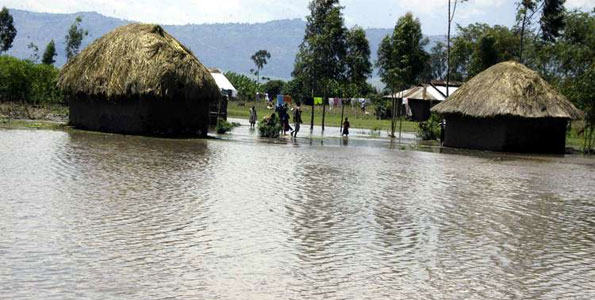
By Jeff Otieno and Apolinari Tairo
East Africans should brace for three months of El Niño rains, local and international meteorologists have warned.
The torrential rains are expected between September and December in most areas, but will extend to February next year in some parts of the greater Horn of Africa region.
“Scientific models show the region will experience El Niño rains, hence governments need to put in place mitigation measures to minimise the damage caused by the heavy rains,†said Peter Ambenje, Kenya’s Director of Meteorological Services.
Mr Ambenje was part of a team of meteorologists from East Africa who met recently in Tanzania to draw up the short rains season forecast for the greater Horn of Africa.
The meteorologists met under the auspices of the Intergovernmental Authority on Development’s Climate Prediction and Applications Centre (CPAC) — an institution established to monitor and advise members on extreme climate events in the region.
The Igad member countries, which form the greater Horn of Africa, are Kenya, Uganda, Rwanda, Burundi, Tanzania, Sudan, Somalia, Djibouti, South Sudan, Ethiopia and Eritrea.
Recently, the World Meteorological Organisation — the UN body for studying weather and ocean-atmosphere interaction — said the 2015-2016 El Niño will probably be the strongest since 1997-1998 and potentially among the top four events since 1950.
According to the ICPAC forecast, almost the whole of the East African region is expected to receive normal to above normal rainfall with the exception of southern Tanzania, which is normally dry during the short rains season.
Areas expected to receive above normal rainfall are Kenya, Uganda, South Sudan and the southern parts of Somalia and Ethiopia, which will also be the most affected by the torrential rains, if proper mitigation measures are not put in place.
An ecological zone is said to receive above normal rainfall when the anticipated amount is 125 per cent above the long-term average of that particular region, normal rains when the figure is between 75 per cent and 125 per cent of the long-term average and below normal rainfall when it is below 75 per cent of the long-term average.
The September to December short rains constitute an important rainfall season in the greater Horn of Africa, and any extreme weather event has a profound negative effect on the economy of the whole region.
El Niño, which is caused by the warming of the eastern and central equatorial Pacific Ocean, is normally associated with massive destruction of property and even loss of lives.
Flash floods and mudslides are common during this period, destroying crops, cutting off communication links and making some areas inaccessible. As a result, East African economies have to pay huge bills to repair damaged infrastructure, once the rains subside.
In the 1997-98 El Niño episode, the total cost of infrastructure damage in Kenya was estimated at $670 million and about 100,000 kilometres of rural and urban roads were destroyed.
“The heavy rains will definitely cause destruction of infrastructure, hence East African countries will have to set money aside for rehabilitation and repair once the rainy season ends,†said Mr Ambenje.
The meteorologist also warned that the region could face an outbreak of diseases, adding that the torrential rains normally create a conducive environment for some tropical diseases to thrive.
During the 1997-98 rains, for example, there was an outbreak of Rift Valley Fever in northeastern Kenya and northern Uganda, with pastoralists losing hundreds of heads of livestock to the viral disease, which is associated with mosquito-borne epidemics during years of unusually heavy rainfall.
The disease not only killed animals but also residents who consumed the infected meat. Apart from Rift Valley Fever, the spread of highland malaria also infected hundreds of people and killed those who did not get adequate treatment.
Tanzania is estimated to have suffered a $117 million loss from damage caused to crops, roads and power lines.
In Uganda, the heavy rains, which are usually associated with strong winds and hailstones, caused massive flooding in Teso, Lango and Acholi regions.
Meteorologists have already warned that mountainous areas like Sironko, Kapchorwa, Mbale, Bundibugyo and Kabale will face increased risk of landslides in the current short rains season.
“It is likely that weather events leading to flash floods may occur in areas with increased likelihood of enhanced rainfall,†said Agnes Kijazi, the director-general of the Tanzania Meteorological Agency.
Mr Ambenje fears the heavy rains will destroy crops and affect the region’s ability to produce adequate food due to post-harvest losses.
Officials from the Sokoine University of Agriculture in Tanzania have also warned of a possible destruction of crops in the country. Among the staples that could be affected are maize, beans, wheat and rice.
Agricultural economist George Mwangi said food prices may increase if heavy crop losses are incurred. As a result, countries may be forced to import more food.
A large chunk of Tanzania, northwestern Kenya, northeastern Uganda and central parts of Rwanda and Burundi are expected to receive normal rainfall.
However, not all parts of the greater Horn of Africa will receive high rainfall.
The northern parts of Sudan, parts of Eritrea, Djibouti, the southernmost part of Tanzania and north Somalia are expected to receive below normal rainfall.
The next extreme weather phenomenon expected to hit the region once El Niño subsides is La Niña, which is associated with drought and lack of rainfall. La Niña and El Niño happen every three to five years.
The catastrophic drought in Kenya, Ethiopia, Djibouti and Somalia in 2011, for example, is thought to be an indirect consequence of the 2010-2011 La Niña.
OP The East African



Recent Comments